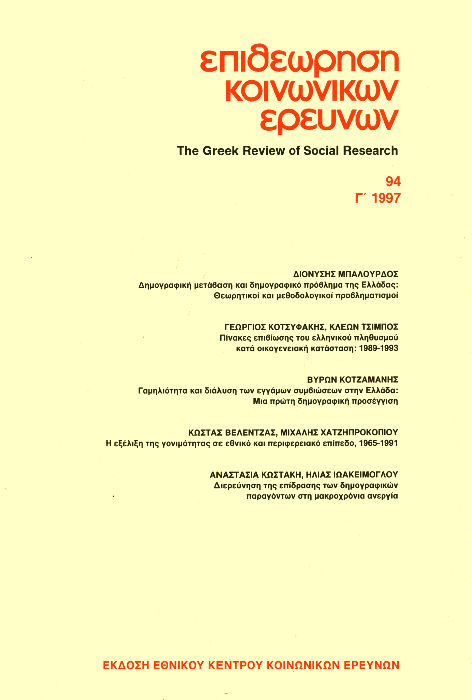Fertility trends in Greece: national and regional analysis, 1965-1991
Abstract
One of the most significant demographic problems appearing in the recent years in our country is the sharp fall of the reproductive ability of the population. The number of children corresponding to a woman of a fertile age today in Greece is less than the minimum required for the replacement of the population. According to the empirical analysis of this study, the phenomenon of the fall of the fertility rates becomes very significant during the period 1980-1988 because of changes of the reproductive behaviour of the youngest mothers. The same pattern of development is observed for all regions of the country. In addition, statistically significant differences between urban and agricultural regions are not observed as far as the reproductive behaviour of mothers is concerned. Finally, the difference of fertility behaviour between Athens, Thessaly, Thrace, Aegian Islands and Crete on the one hand and the national average on the other is tatistically significant.
Article Details
- How to Cite
-
Βελέντζας Κ., & Χατζηπροκοπίου Μ. (1997). Fertility trends in Greece: national and regional analysis, 1965-1991. The Greek Review of Social Research, 94, 153–183. https://doi.org/10.12681/grsr.718
- Issue
- 1997: 94 Γ'
- Section
- Articles

This work is licensed under a Creative Commons Attribution-NonCommercial 4.0 International License.
Authors who publish with this journal agree to the following terms:
- Authors retain copyright and grant the journal right of first publication with the work simultaneously licensed under a Creative Commons Attribution Non-Commercial License that allows others to share the work with an acknowledgement of the work's authorship and initial publication in this journal.
- Authors are able to enter into separate, additional contractual arrangements for the non-exclusive distribution of the journal's published version of the work (e.g. post it to an institutional repository or publish it in a book), with an acknowledgement of its initial publication in this journal.
- Authors are permitted and encouraged to post their work online (preferably in institutional repositories or on their website) prior to and during the submission process, as it can lead to productive exchanges, as well as earlier and greater citation of published work (See The Effect of Open Access).
Downloads
Download data is not yet available.



